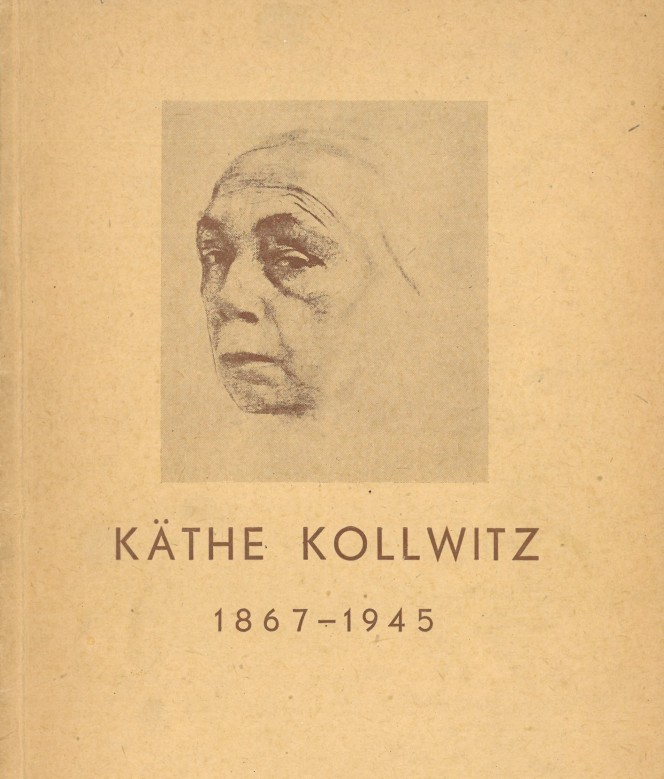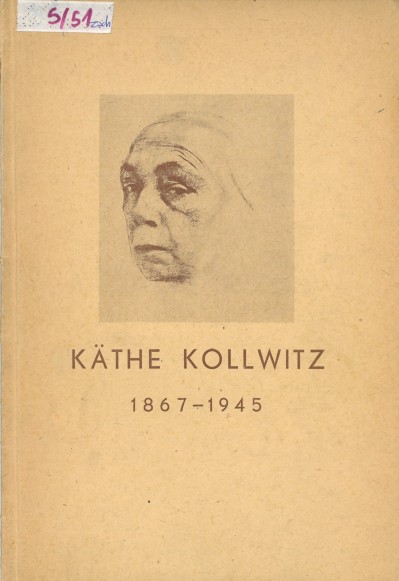Käthe Kollwitz (1867–1945) Graphic Arts – sculpture
20.06 – 21.07.1951 Käthe Kollwitz (1867–1945) Graphic Arts – sculpture
Zachęta Central Bureau of Art Exhibitions (CBWA)
organiser: Committee for Cultural Cooperation with Foreign Countries, Central Bureau of Art Exhibitions
commissioner: Otto Nagel
‘On the eve of liberation, 22 April 1945, Käthe Kollwitz dies, not living to see how a new democratic Germany, the Germany for which she fought with the whole heart of a progressive artist, arises with the support of the Soviet Union,’ Stanisław Hen writes in his review of the presentation held in the Central Bureau of Art Exhibitions (CBWA).[1]
In the 1950s, the CBWA hosted two individual exhibitions of German artists: Käthe Kollwitz (1951) and Otto Nagel (1955). These displays are representative of the programme drawn up by the Committee for Cultural Cooperation with Foreign Countries (KWKZ), an institution acting within the office of the Prime Minister from 1950 to 1956. The plan of the exhibitions arranged by the KWKZ reflected the national policy which promoted cultural exchange between the Polish People’s Republic (PRL), the USSR and the Eastern Bloc. Although cultural exchange with Western countries was also taken into consideration, it was treated instrumentally, by choosing phenomena and artists critical of the capitalist system. In the case of cultural exchange between the Polish People’s Republic and the German Democratic Republic (GDR), the exhibitions of Kollwitz and Nagel adhered to the policy of presenting artists described at that time as ‘progressive’.[2]
The displaying of Kollwitz at Zachęta can be perceived as one of many events encouraging cooperation between the PRL and GDR after the signing of the Treaty of Zgorzelec in 1950, which recognised the borders between the two states. The collection of documents related to the activity of KWKZ include draft speeches delivered during the show vernissages (e.g. of the GDR ambassador in Warsaw, Stefan Heyman), stressing, in the vein of the political rhetoric of the day the necessity for ‘mutual cooperation and friendship’.[3]
There were 90 works put on display: 66 prints made in different techniques, 5 drawings, 12 reproductions, 6 sculptures, plus one sculpture shown solely in 2 photographs. Serving as exhibition curator was Otto Nagel, a guardian of the legacy of Käthe Kollwitz, vice-president of the East German Academy of Arts (Akademie der Künste der DDR) and president of the Association of German Artists.
The exhibition was accompanied by a catalogue containing a list of the works, eight reproductions, a selection of fragments of memoires by Kollwitz entitled Käthe Kollwitz w pamiętnikach i listach (there is no information about the authors of the selection, translation or notes) and an unsigned preface, being an abridged version of Urszula Pomorska’s text published in Przegląd Artystyczny.[4]
The Central Bureau of Art Exhibitions featured Kollwitz’ output from 1892–1938. The main works included two cycles of engravings, A Weavers’ Revolt from 1897, Peasants’ War from 1903, and the print Never again War! (Nie wieder Krieg!) from 1924. The latter was the most frequently reproduced exhibit in the press, emphasising the political engagement of the artist and reinforcing the narrative about the development of peaceful relationships between the PRL and the GDR. The title phrase Nie wieder Krieg! had been a famous slogan of pacifist organisations since 1919. The chosen print cycles were intended to demonstrate the aspect of Kollwitz’ oeuvre essential for the Warsaw presentation, that of social involvement, leaving aside more personal or symbolic themes. The motif of a mother and a widow, nowadays a subject which attracts the keen interest of researchers of Kollwitz’ works, was not underscored at the exhibition.[5] Nevertheless, the cycles of drawings and prints created after 1914 under the influence of war experiences and the death of the artist’s son fit in with the anti-war message.
The revised interpretation of the works of Kollwitz in the early years of the Polish People’s Republic allows us to understand how her output was received, regarded as part of a Socialist Realist discourse. In a text printed in Nowa Kultura, Otto Nagel introduces the engraving cycles of Kollwitz and outlines the circumstances of their creation.[6] The key to the exhibition was an attempt to present Kollwitz as an artist both ‘progressive’ and realist. Nagel tries to show her, above all, as his friend, and refrains from setting her oeuvre in any artistic context. The background to the understanding of the printmaker’s art is only her ‘revolutionary temperament, sensitivity, emotionality, life experience and inspiration found in The Weavers by Gerhart Hauptmann’.[7] The artist became acquainted with the writer in London in 1886, while the reading of The Weavers inspired her to produce a series of illustrations in 1893–1987.
Both Nagel and the above-mentioned Pomorska point out the heart-breaking and pessimistic overtones of the artist’s works. This feature is also noticed by other reviewers. The author of the article run in Głos Robotniczy explains this ‘output of sadness’ by ‘the era of capitalist oppression and terror of the war during which the artist lost her son. Viewers of the exhibition can be comforted by the love of peace of the present generations and the advocacy of freedom and the democratic system’.[8]
An article in Tygodnik Powszechny, as one of a few voices, places the output of Kollwitz in a broader artistic tradition: ‘Käthe Kollwitz, a painter of proletarian poverty and revolt of the oppressed, is a chief representative of so-called German expressionism in visual arts, also exemplified by the works of Pechstein, Nolde, Kokoschka, and the Die Brücke group.’[9]
The photos documenting the event prove that the exhibition was remarkably simple. The works on paper hung at regular intervals, aligned to the bottom, in identical frames, with a white passe-partout. No attempt was made to dramatise the show by the arrangement of works or lighting. The whole dramatic tension and pessimism of the exhibition, its depressing character stressed in the reviews, emanated from the very engravings which were neutrally displayed at the gallery. However, the reality outside the gallery should also be remembered, as the event was organised in Warsaw, still under reconstruction, only six years after the end of the war.
Stanisław Welbel
Institute of Art of the Polish Academy of Sciences
education department of Zachęta — National Gallery of Art
This compilation was prepared as part of the National Programme for the Development of Humanities of the Polish Minister of Science and Higher Education — research project The History of Exhibitions at Zachęta — Central Bureau of Art Exhibitions in 1949–1970 (no. 0086/NPRH3/H11/82/2016) conducted by the Institute of Art History of the University of Warsaw in collaboration with Zachęta — National Gallery of Art.
Bibliography
Catalogue:
- Käthe Kollwitz (1867–1945). Grafika — Rzeźba. Warsaw: Centralne Biuro Wystaw Artystycznych, 1951.
Source texts:
- Chylińska, K. ‘Twórczość buntu i walki (Wystawa prac Käthe Kollwitz w „Zachęcie” warszawskiej)’. Głos Robotniczy, no. 181, 3 July 1951
- ‘Grafika w służbie proletariatu’. Dziennik Bałtycki, no. 229, 19/20 August 1951
- Hen, Stanisław. ‘Käthe Kollwitz w „Zachęcie”’. Express Wieczorny, no. 195, 18 July 1951
- Nagel, Otto. ‘Käthe Kollwitz’. Nowa Kultura, no. 26(66), 1951, p. 8
- Pomorska, Urszula. ‘Wystawa dzieł Käthe Kollwitz w warszawskiej „Zachęcie”’. Przegląd Artystyczny, no. 4, 1951, pp. 3–11
- Turwid, M. ‘Sztuka Käthe Kollwitz’. Ilustrowany Kurier Polski, no. 180, 1 July 1951
- Z. W. Sztandar Młodych, ed. 27B, no. 164, 11 July 1951.
Press mentions:
- Kurier Codzienny, no. 170, 21 June 1951
- Trybuna Ludu, no. 172, 22 June 1951
- Tygodnik Powszechny, no. 26, 9 June 1951
Compilations:
- Abschied und Tod. Acht Zeichnungen von Käthe Kollwitz. Mit einem Geleitwort von Gerhart Hauptmann. Berlin, 1924
- Braun, M. Kulturinsel und Machtinstrument. Die Akademie der Künste, die Partei und die Staatssicherheit. Göttingen, 2007
- Hilscher, E., U. Hilscher, eds. Würdigungen und Briefe von Käthe Kollwitz und Gerhart Hauptmann. Berlin, 1987
- Hintz, R. Käthe Kollwitz: Graphics, Posters, Drawings. New York, 1981
- Nagel, O. Die Selbstbildnisse der Käthe Kollwitz. Berlin, 1965
- Welbel, Stanisław. ‘Käthe Kollwitz and Otto Nagel: Two Exhibitions of “Progressive Artists” at the Zachęta in the Framework of Cultural Cooperation with the German Democratic Republic’. Ikonotheka, no. 26, 2016, pp. 111–136
- Whitner, Claire C., ed. Käthe Kollwitz and the Women of War: Femininity, Identity, and Art in Germany During World Wars I and II. New Haven, CT, 2016
[1] Stanisław Hen, ‘Käthe Kollwitz w „Zachęcie”’, Express Wieczorny, no. 195, 18 July 1951.
[2] Cf. Stanisław Welbel, ‘Käthe Kollwitz and Otto Nagel: Two Exhibitions of “Progressive Artists” at the Zachęta in the Framework of Cultural Cooperation with the German Democratic Republic’, Ikonotheka, no. 26, 2016, pp. 111–136.
[3] KWKZ [Committee for Cultural Cooperation with Foreign Countries] Files, AAN [Archive of New Records], file no. 258 [exhibitions of visual artists’ works from the GDR in Poland in 1952–1956].
[4] Cf. Urszula Pomorska, ‘Wystawa dzieł Käthe Kollwitz w warszawskiej „Zachęcie”’, Przegląd Artystyczny, no. 4, 1951, pp. 3–11.
[5] Cf. Käthe Kollwitz and the Women of War: Femininity, Identity, and Art in Germany During World Wars I and II, ed. Claire C. Whitner, New Haven CT, 2016.
[6] Otto Nagel, ‘Käthe Kollwitz’, Nowa Kultura, no. 26 (66), 1951, p. 8.
[7] Ibid.
[8] K. Chylińska, ‘Twórczość buntu i walki (Wystawa prac Käthe Kollwitz w „Zachęcie” warszawskiej)’, Głos Robotniczy, no. 181, 3 July 1951.
[9] [untitled], Tygodnik Powszechny, no. 26, 9 July 1951.
Käthe Kollwitz (1867–1945)
Graphic Arts – sculpture
20.06 – 21.07.1951
Zachęta Central Bureau of Art Exhibitions (CBWA)
pl. Małachowskiego 3, 00-916 Warsaw
See on the map

